Competition is fierce on the global stage, and the Beef Checkoff works diligently to encourage foreign countries to feature U.S. beef as their best protein choice. As a result of the Checkoff’s efforts, more consumers around the world want the high-quality products cattlemen and women produce – growing demand and increasing the value of U.S. beef.
Here are seven ways the U.S. Meat Export Federation (USMEF) has recently worked to grow beef demand abroad, funded in part by the Beef Checkoff.
- Hong Kong Event Promotes American Barbecue and Celebrates Foodservice
The 14th edition of the Great American Texas Barbecue Hong Kong attracted 850 chefs, merchandisers, restaurant owners, distributors and U.S. suppliers, who turned out to sample American barbecue, reconnect with industry partners, and learn new menu ideas and concepts. Brisket, ribs and sausages were expertly cooked and smoked while new items such as the Steamship Round were featured.
- New Industry Resource Captures Culinary Evolution of the Caribbean
The Contemporary Caribbean Cuisine textbook promotes the incorporation of U.S. beef and pork into Caribbean cuisine, honoring local traditions and regional variations. Developed in collaboration with local food scholars and chefs, the textbook is a comprehensive resource for culinary schools and professionals, highlighting the diverse cultural influences shaping Caribbean dishes. The USMEF will promote this book across the region, offering support through seminars and chef-training programs to encourage the exploration of traditional and innovative U.S. beef recipes.
- Beef Nutrition Showcased at IRONMAN Event in Colombia
USMEF partnered with Colombian importers during an IRONMAN competition in Cartagena to promote the nutritional benefits and availability of high-quality U.S. beef. With a focus on health-conscious athletes and families, USMEF showcased U.S. beef’s versatility and superior taste, emphasizing its role in optimizing athletic performance. Through interactive demonstrations, medical insights and sampling opportunities, USMEF aimed to educate participants about the importance of incorporating protein-rich red meat into their diets.
- Butcher Certification Program Broadens U.S. Red Meat Utilization in China
USMEF collaborated with FAN Culinary Education in Shanghai to certify 56 meat cutters in China as official U.S. red meat butchers. FAN Culinary Education is endorsed by the World Association of Chefs’ Societies, and its founder, Clinton Zhu, is a celebrity chef with more than 20 years of experience in the red meat industry. This effort targeted professionals in the processing, retail and foodservice sectors, where they learned about the production practices and sustainability of the U.S. red meat industry. Also, attendees participated in hands-on cutting demonstrations and discussions and learned about the culinary potential of underutilized cuts, such as the beef chuck roll and beef tri-tip.
- USMEF Leads Buyers from China to Korea to Study Innovations in Prepared Food
As consumer demand for prepared foods expands in China, food processing companies want to expand operations to meet opportunities in this category. With inflation and rising input costs complicating such plans, USMEF has been working to show current buyers how U.S. beef can be utilized in prepared food products. Korea is considered a regional market leader in prepared foods, with category sales skyrocketing in recent years. USMEF led a team of 10 buyers from China to Korea, teaching them about product innovations in ingredients, cooking techniques and production. USMEF also led the team on a retail tour to demonstrate how prepared foods are merchandised and sold in Korea.
- Training Programs Build Awareness and Demand for U.S. Red Meat in Indonesia
To expand awareness and grow demand for U.S. beef in Indonesia, USMEF conducted training seminars in Jakarta for importers, retailers and foodservice operators. A retail training session was conducted for 40 participants from upscale retail butcher outlets, and the first-ever foodservice training session was conducted with an importer and several high-end foodservice operators. The fundamentals of U.S. red meat production, the U.S. grading system and high-quality attributes of grain-fed U.S. red meat were highlighted during the seminars, including cutting demonstrations and idea sharing about cut applications in regional cuisines. The foodservice seminar also featured a friendly cooking competition among 15 of the participants, using U.S. beef top blade.
- USMEF Video Promotes U.S. Red Meat Sustainability in International Markets
Sustainability is of growing importance in international markets, and USMEF is working to promote the industry’s commitment to sustainability as a differentiator for U.S. red meat products. USMEF shares the U.S. sustainability message with international trade and consumers through educational and promotional activities, including advertising and social media. For that effort, USMEF created a video illustrating how U.S. producers’ commitment to the land they work and the animals they raise translates to delicious meals at the table around the world. Watch the video.

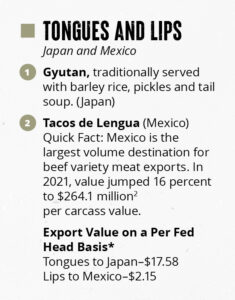 USMEF carries out market development activities in more than 80 countries. With such expansive areas to cover, USMEF takes a boots-on-the-ground approach, hiring 16 international representatives and offices worldwide. As locals, these USMEF professionals know and understand their marketplace, as well as the trends and consumer preferences in their area. These Checkoff program leaders help execute promotional campaigns and initiatives and increase market access in their areas. Many of these global markets specifically have a high demand for U.S. beef variety meats. The Beef Checkoff also works with USDA’s Foreign Agricultural Service to utilize their Market Access Program (MAP). Every Checkoff dollar is matched with MAP funds to share the costs of marketing and promotional activities overseas to drive demand for beef.
USMEF carries out market development activities in more than 80 countries. With such expansive areas to cover, USMEF takes a boots-on-the-ground approach, hiring 16 international representatives and offices worldwide. As locals, these USMEF professionals know and understand their marketplace, as well as the trends and consumer preferences in their area. These Checkoff program leaders help execute promotional campaigns and initiatives and increase market access in their areas. Many of these global markets specifically have a high demand for U.S. beef variety meats. The Beef Checkoff also works with USDA’s Foreign Agricultural Service to utilize their Market Access Program (MAP). Every Checkoff dollar is matched with MAP funds to share the costs of marketing and promotional activities overseas to drive demand for beef.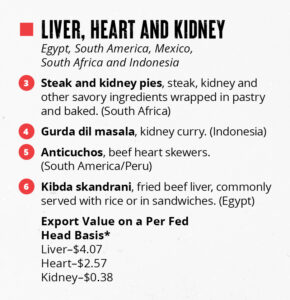
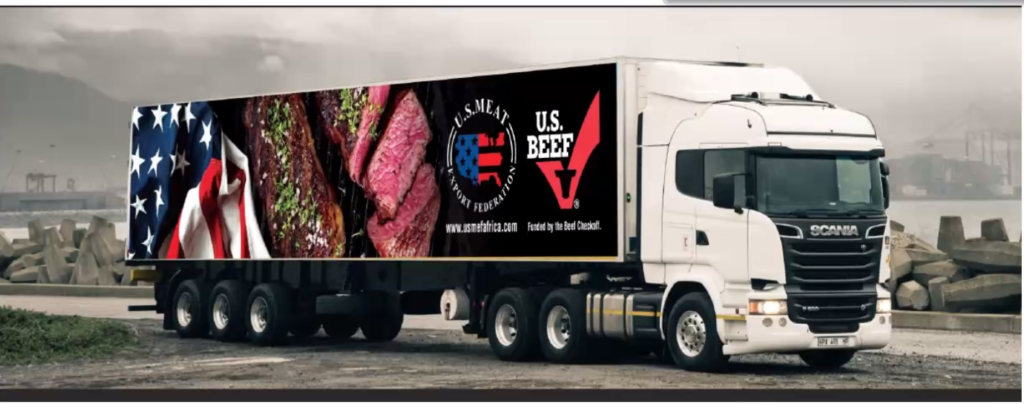 To deliver the high-quality protein consumers want, Copeland is working aggressively to expand the number of importers and distributors in the region who purchase U.S. beef. Also, Copeland is executing efforts to introduce beef to the retail and HRI sectors in South Africa. One of these efforts was a brochure outlining the quality attributes of beef liver in the Zulu language, and it was translated into French for use in Morocco. USMEF also plans to print the brochure in the Xhosa language as well.
To deliver the high-quality protein consumers want, Copeland is working aggressively to expand the number of importers and distributors in the region who purchase U.S. beef. Also, Copeland is executing efforts to introduce beef to the retail and HRI sectors in South Africa. One of these efforts was a brochure outlining the quality attributes of beef liver in the Zulu language, and it was translated into French for use in Morocco. USMEF also plans to print the brochure in the Xhosa language as well.
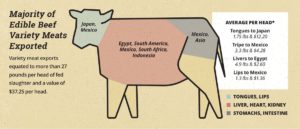 For example, in Peru, USMEF launched an initiative to promote the benefits of U.S. beef liver in helping combat anemia. This project included medical students greeting consumers in butcher shops and supermarkets to share information about healthy eating habits and how consuming beef liver increases iron intake. The motivation for this campaign came from a Peruvian Health Ministry report that revealed anemia cases in Peru have risen in recent years due to iron-deficient diets, with the country’s national anemia rate in children at a startling 47 percent. This campaign was a massive success. Arisa, a distributor that deals mostly with wet markets in Lima, Peru, experienced a 23 percent increase in U.S. beef liver sales during the promotion. Grupesac, a retailer with two outlets where U.S. beef liver accounts for 60 percent of total sales, saw a 22 percent increase
For example, in Peru, USMEF launched an initiative to promote the benefits of U.S. beef liver in helping combat anemia. This project included medical students greeting consumers in butcher shops and supermarkets to share information about healthy eating habits and how consuming beef liver increases iron intake. The motivation for this campaign came from a Peruvian Health Ministry report that revealed anemia cases in Peru have risen in recent years due to iron-deficient diets, with the country’s national anemia rate in children at a startling 47 percent. This campaign was a massive success. Arisa, a distributor that deals mostly with wet markets in Lima, Peru, experienced a 23 percent increase in U.S. beef liver sales during the promotion. Grupesac, a retailer with two outlets where U.S. beef liver accounts for 60 percent of total sales, saw a 22 percent increase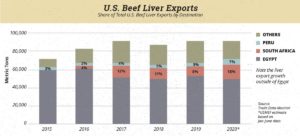 Adding Value Back to Producers
Adding Value Back to Producers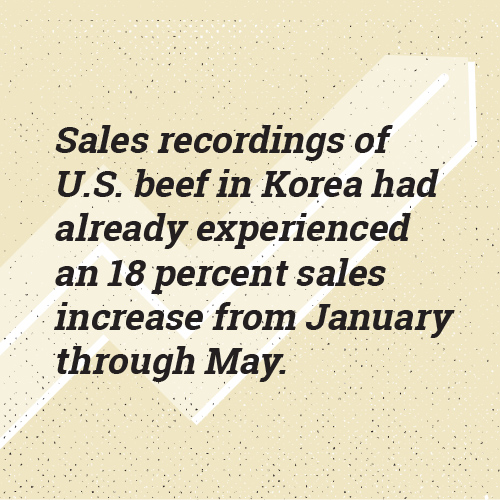 4. Product Samplings in South Korea
4. Product Samplings in South Korea